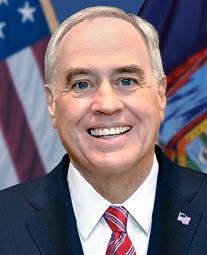New York’s Economy and Finances in the COVID-19 Era
March 18, 2021 Edition
Economy
Four Out of Five Small Businesses in NY Continue to Report a Negative Overall Impact From COVID-19
One year since the onset of the COVID-19 pandemic, New York’s small businesses continue to suffer, even as the economy reopens gradually and employment growth resumes. Seventy-eight percent of small businesses (with less than 500 employees) surveyed reported an overall negative impact in their business in the first week of March 2021, according to the U.S. Census Bureau. The share has declined from 94 percent in April 2020 when data were first reported, but has plateaued at approximately 80 percent since October 2020.
The share of New York’s small businesses reporting negative impacts has been consistently greater than the national average, which has also declined more quickly. In April 2020 almost 90 percent of small businesses nationally reported a negative impact; by the first week of March that figure declined 18 percent to 72 percent.
Source: U.S. Census Bureau, Small Business Pulse Survey, updated March 12, 2021.
For many small businesses, the pandemic quickly resulted in revenue decline. According to the Census Bureau, 77 percent of New York’s small businesses reported a decrease in revenues, sales or receipts, not including financial assistance or loans, at the end of April 2020. While few small businesses report that revenues are growing, most are no longer seeing declines: only 27 percent reported declines in the first week of March while 65 percent reported no change.
Source: U.S. Census Bureau, Small Business Pulse Survey, updated March 12, 2021.
Federal relief for small businesses included two major programs offering financial assistance: the Paycheck Protection Program and the COVID-19 Economic Injury Disaster Loans. Economic Injury Disaster Loans are available for a 30-year term with payments deferred for one year. The Paycheck Protection Program provides small businesses loans for payroll and other qualified expenses. The loans can be forgiven if the businesses retain employment levels and meet other conditions, essentially turning the loan into a grant. As of March 7, 2021, New York State businesses received 508,650 loans totaling $51.9 billion.
The recently enacted American Rescue Plan Act of 2021 authorizes several new and continuing programs for small businesses, including expansion of the Paycheck Protection Program to small nonprofits, a new relief fund for restaurants, and funding for cultural institutions and performing arts venues. A new $10 billion Small Business Opportunity Fund would also target funding to states with higher unemployment for state programs to provide loans or assist with small business credit access. As New York’s unemployment rate remains fourth highest in the nation, it will likely benefit a great deal from this fund.
Budget
American Rescue Plan Act of 2021
The American Rescue Plan Act of 2021, signed into law by President Joseph Biden last week, also provides New York State approximately $45 billion in fiscal relief to governmental entities and major institutions. New York State will receive $12.6 billion, New York City will receive $5.9 billion and other local governments will receive $4.9 billion. There is additional funding for K-12 education ($9.0 billion), higher education institutions ($2.6 billion) including the State and City Universities of New York, the Metropolitan Transportation Authority ($6.5 billion) and Medicaid reimbursement, among other programs.
The map and bar chart below show federal relief expected for each county in New York. Note amounts for the five counties of New York City do not include $4.3 billion directly allocated to the City.
New York State Budget
The New York State Executive Budget for State Fiscal Year (SFY) 2021-22 assumed $6 billion in federal relief for SFY 2021-22 and SFY 2022-23, but included an additional $9 billion special appropriation should the federal government provide $15 billion in federal aid requested by the Governor. While the federal aid enacted is more than double the $6 billion budgeted, the Executive Budget is opaque about how these federal funds will be used, as explained in greater detail in the Comptroller’s Report on the Executive Budget for SFY 2021-22.
In addition to $12.6 billion in federal aid, the Governor and Legislature agreed to recognize an additional $2.5 billion in tax resources in SFY 2020-21 and SFY 2021-22 as part of the Consensus Forecast announced on March 1. The State’s tax receipts totaled $75.0 billion in February, which was $758 million more than the Executive Budget projection, as shown in the Comptroller’s monthly cash report.
The SFY 2021-22 Financial Plan indicates these combined resources may obviate the need for most of the contingency measures, which included personal income tax increases, school aid cuts and delays in salary increases for public employees.
Prior Editions
- March 4, 2021
- February 18, 2021
- February 3, 2021
- January 21, 2021
- January 7, 2021
- December 16, 2020
- December 2, 2020
- November 12, 2020
- October 28, 2020
- October 14, 2020
- September 30, 2020
- September 16, 2020
- September 2, 2020
- August 19, 2020
- August 5, 2020
- July 22, 2020
- July 9, 2020
Additional Resources
- Report on the State Fiscal Year 2021-22 Executive Budget
- COVID-19 Financial Survival Toolkit
- State Cash Basis Reports
- Report on the State Fiscal Year 2020-21 Enacted Budget Financial Plan
- Report on the State Fiscal Year 2020-21 Enacted Budget: Budgeting in a Time of Crisis
Subscribe for Latest Updates
The State Comptroller’s Office is committed to keeping New Yorkers regularly updated on the State’s economy and finances. Subscribe to get the latest update.



